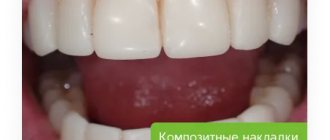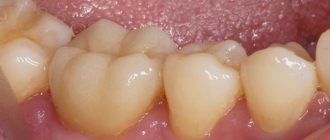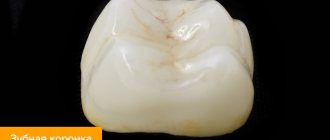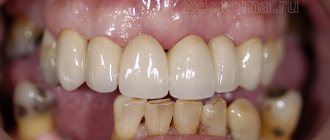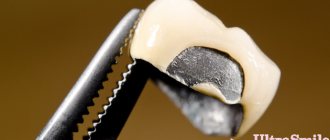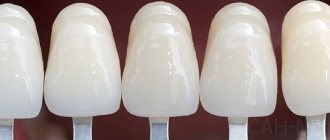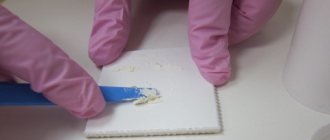Metal ceramics cause gums to turn blue
Each metal in the alloy has its own reaction to the body. Most often, standard alloys oxidize over time, which leads to gum subsidence and discoloration, which can occur over time. This occurs if standard crowns with an uncovered lower metal part were used. When using crowns with shoulder mass, or, as they are also called, increased aesthetics, the place where the metal adheres to the gum is closed, which helps prevent swelling of the mucous membrane, discoloration, and rapid subsidence.
What is a metal-ceramic crown?
A metal-ceramic crown is a permanent dental prosthesis that is fixed to the remaining tooth. Consists of a metal frame and layered ceramic coating. More than 500 alloys are used in dentistry; alloys based on:
- gold from 70% in alloy;
- gold and other precious metals (25-50%);
- palladium (more than 50%).
The strength of the finished product depends on the frame; if it is thin, the overall resistance to occlusal load will decrease. A thick base worsens the appearance, because... over time we will shine through the ceramics. Dental technicians adhere to the rule that the minimum thickness of the frame is 0.3-0.4 mm, the maximum depends on the tooth being replaced. The thickness of the metal-ceramic prosthesis is 1.1-2.0 mm.
These crowns are designed to cover individual teeth, as well as to secure bridges in visible areas of the dentition. They are installed as a replacement for the front and chewing teeth.
Attention: if part of the crown veneer breaks off, it will not be possible to restore the integrity of the patient’s oral cavity. She is being removed.
Metal-ceramic dental crowns are not stained by food and do not have a harmful effect on surrounding tissues. The approximate service life is 5 - 15 years, depending on the materials used and manufacturing technology. The more expensive the materials and the more elaborate the manufacturing technique, the longer the crown will last (a gold-platinum alloy as a frame increases the service life to an average of 20 years).
Metal crowns with ceramic coating
Zirconium or cermet
To better understand the differences, strengths and weaknesses of metal-ceramic crowns, you should compare them, for example, with the same products, but made of zirconium dioxide. This material has been used in dentistry for many years. When compared to metal-ceramic products, zirconium dioxide crowns are much better aesthetically. Their transparency and color are as close as possible to natural teeth. Also, zirconium is not subject to deformation and does not change color over time, which sometimes affects products made from metal ceramics.
Products made from zirconium dioxide are hypoallergenic. And completely biocompatible. They have excellent thermal insulation and will be a real salvation for people with high sensitivity who react to cold and hot.
However, this type of material also has disadvantages. And the most important of them is the price. Crowns made of zirconium dioxide will cost much more than the same ones made of metal-ceramics. Therefore, you will have to pay a lot for the advantages in the form of beautiful aesthetics.
Indications and contraindications for installing metal ceramics
These dental crowns are used for aesthetic prosthetics. Main indications:
- Destruction of the natural crown of a tooth by caries, trauma, non-carious lesions, etc., which cannot be restored with filling.
- Traumatic tooth fracture.
- Darkening of color or hypoplasia of enamel.
- Dental abnormalities.
- Fluorosis.
- Restoration of the lower part of the face with pathological abrasion.
- How to fix a prosthesis (removable, bridge).
- When splinting teeth for periodontitis.
- Replacing dentures.
Contraindications for installing metal-ceramic crowns are relative (sometimes it is enough to carry out preliminary treatment):
- Age up to 16 years (intact pulp).
- Teeth with fragile, thin crowns (often this applies to the lower incisors).
- Blocking bite, when the lower incisors completely overlap the upper incisors.
- Pathological abrasion of teeth and a decreasing bite (will lead to breakage of the metal-ceramic crown if the bite was not corrected and myostatic reflexes were changed before installation).
- Parafunctions of the masticatory muscles (for example, bruxism).
- Diseases of marginal periodontium due to possible functional overload of teeth.
Allergy sufferers and people with gastrointestinal diseases need to be very careful when choosing a metal frame, since the constant presence of metal can cause a deterioration in well-being over time. For such patients, a gold base is recommended. Doctors also do not recommend nickel-chromium alloys even for healthy people, since there is a tendency for general immunity to decrease and a surge in autoimmune diseases and the gastrointestinal tract.
Installation on the front teeth
When creating crowns, dental technicians pay attention to the aesthetics of the structure, since the front teeth are not only involved in chewing food, but also enter the smile zone. Therefore, when restoring the anterior dentition, dentists take into account the following:
- Crowns should be parallel to eye level;
- The gap between the central incisors should be strictly in the center of the face;
- The teeth on the right and left should be symmetrical and similar in shape.
Microprostheses on the front teeth are more susceptible to chipping due to the thin cutting edge. To eliminate this risk factor, dentists carefully check the bite using articulation paper.
Stages of installing a metal-ceramic crown
Prosthetics are more the work of a dental technician than an orthodontist. The crown will be made in 7-10 days. However, before installation, it is necessary to prepare the patient, carry out appropriate treatment if necessary, and also prepare the tooth. Therefore, you will need to visit the clinic 4-5 times (it is possible to combine several stages in one visit). If problems are discovered, the number of visits to the doctor will increase.
The presence of a pain symptom during installation of a prosthesis depends on the tooth:
- on the pulpless one the pain is not felt. However, if you ask for additional anesthesia, they will give it;
- on “living” teeth, with the root preserved, there is an unpleasant sensation, pain is felt during grinding. Anesthesia solves the problem, but it is advisable to do a test to avoid an allergic reaction.
When installing dental crowns, when a temporary prosthesis is installed, the edge of the gum may be damaged and discomfort may be felt, but this is a normal process - no medications are required. If there is increased nervous excitability, the pain threshold is low - you can take sedatives and painkillers (be sure to discuss this issue with your dentist!).
Diagnostics before installing crowns is necessary
Diagnostics
Clinical assessment of the oral cavity and tooth damage is a mandatory step before installation. This is an examination, the manipulations are painless. Orthodontist:
- examines the tooth, checking the severity of the midline (equator), the degree of destruction;
- notes fillings, degree of tooth mobility;
- identifies defects in bite and dentition;
- checks the distribution of occlusal load;
- pays attention to periodontal disease.
An x-ray may also be needed if there is inflammation or a suspected tumor. If there is no inflammatory process (it must be eliminated before installation), the tooth is cleaned of plaque and caries is treated. They are filled, if necessary, removing the nerve and additionally filling the canals.
Tooth preparation
Preparing a tooth for a metal-ceramic crown means grinding off part of the tooth so that the crown placed on top is in line with the rest of the teeth and does not interfere. The walls are shortened and smoothed, the tooth shape becomes cylindrical.
If the tooth root is healthy, the nerve is not removed. They try to keep the tooth alive, then it will not “dry out” under the crown - the service life of the metal-ceramics will increase. The abutment tooth for a metal-ceramic crown is prepared much more than when preparing to install an all-ceramic crown. Focus on the rules:
- The color of the structure, close to the natural tooth, is obtained by distributing the thickness of the ceramic: center - 1.3-1.4 mm;
- cutting part - 1.5-1.6 mm.
Like any dental procedures in the mouth, preparation is not the most pleasant, but it does not cause severe pain. At the patient’s request, the doctor will always inject an anesthetic to make him feel comfortable. When the preparation is not gentle, a significant amount of enamel and dentin (about 2 mm of hard tissue) is ground off; full anesthesia is performed with a living (intact) pulp.
Taking an impression, installing a temporary prosthesis
The orthodontist needs an impression of the upper and lower jaws to correctly make the crown so that the prosthesis is not perceived as something foreign. On the model made in plaster according to the cast, the height of the product, the angle of inclination, and the evenness of the dentition will then be checked. Sometimes an impression is made of the antagonist teeth and only the jaw where the crown will be installed.
Impression of teeth for making crowns
When making such crowns, impressions are used consisting of 2 layers:
- indicative (basic);
- clarifying (correcting).
First, gum retraction is performed under anesthesia to move it away from the tooth. The most painless method is mechanical, when the gum tray is opened using a thread soaked in a retraction compound. The groove opens, exposing the space between the tooth and the soft tissue.
An inlay is placed on the tooth, since any crown can be installed on it. The first impression is made using impression material and a special tray with perforations. Then the retraction thread is removed, a second layer (corrective) is applied, and the impression tray is again placed on the dentition according to the dental impressions. While the crown is being made, the orthodontist will install a temporary composite, and the patient will wear it for 1-2 weeks.
Manufacturing of a metal-ceramic crown
Stages of manufacturing a metal-ceramic crown:
- Creating a Casting Mold
- Formation of a metal frame
- Application and fixation of dentin, enamel, transparent layers
- Retouching with dye does not imitate carious lesions, only the necessary natural darkening.
The frame is modeled using different methods. For example, the Adapt method. The metal base is obtained by pressing a stamp. A more “jewelry” method is wax modeling. To make a metal-ceramic crown, a mock-up is first prepared from wax that accurately depicts the contours of the finished crown. Then the wax is cut off (this creates a platform for the ceramics), and a fireproof mold is prepared for casting.
The frame of the metal-ceramic crown, which has cooled after casting, is carefully removed and cleaned of the remains of the molding material, dissolving them in an acid solution. The sprue channels (through which the melt was poured into the mold) are removed and sent for a 10-minute firing. The temperature in the oven is 950-1000°C. After cooling, the metal base is adjusted to the required dimensions on the supporting tooth and ground.
Features of manufacturing a metal frame depend on the type of material:
- Soft alloys with a gold content of more than 70%. To prevent the appearance of bubbles on the surface, the finished area for ceramics is treated with a cutter or carbide boron, cleaned with steam, a solvent (for example, carbon tetrachloride or chloroform).
- Alloys of gold-palladium, gold-palladium-silver, palladium-silver and palladium-copper. Their peculiarity: they can change the color of the finished crown. Silver can “color” ceramics yellowish; copper will give a greenish tint. The finished area for the ceramic mass is treated with corundum grinding heads, cleaned in a sandblaster, and small deposits and dust are removed with steam or an organic solvent. Palladium in the base of most alloys absorbs (absorbs) air; when fired, oxygen, nitrogen and hydrogen are released, forming bubbles on the surface. Therefore, the formation of the frame includes the stage of vacuum heat treatment (degassing), when the temperature is maintained at 1000°C. The surface darkens to black.
- Nickel-chromium alloys. Corundum heads are used in processing. The ground frame is then heated to form an oxide film on the surface. Next, the metal base is polished with aluminum oxide particles using a microsandblaster and cleaned with a solvent or steam cleaner.
An opaque mass is applied in thin layers to the prepared metal-ceramic crown frame, which forms the dentin layer. For a natural depth of color, as in a healthy tooth, the first layer is the contour of the crown, setting the shape by cutting off the excess.
Further production of the metal-ceramic crown and ceramic superstructure is divided into 2 volumetric stages:
- Application of dentin coating followed by modeling.
- Condensation, i.e. vibration (for uniform distribution), blotting off excess moisture with special napkins and drying under a stream of hot air.
Manufacturing of metal-ceramic crowns
“Finger-shaped” grooves, which are very clearly visible under the enamel of a real tooth in young people, are obtained by cutting off small sections from the workpiece and smoothing the cuts with a brush. To give the metal-ceramic crown the effect of opalescence (dispersion of light), a lighter enamel mass is applied in the next layer. The final layer is colorless; it is this layer that gives the crown transparency and depth comparable to natural tooth enamel. The technician can even draw cracks (relevant for older patients), darken some areas (intertubercular space and cervical area) so that the metal-ceramic crown in the dentition looks natural.
Fitting and fixation of a metal-ceramic crown
Before installing a metal-ceramic crown, the patient wears a temporary one. All this, together with the temporary cement, is cleaned and the stump is dried. To prevent saliva from getting onto the base, a retraction thread is used. First, simply put on the crown to check the tightness of the fit. Only then does the final fixation of the metal-ceramic crown take place.
Each orthodontist has its own quality control. Some use a strip of paper, others check the installation with dental floss (a piece of paper, thread is held tightly between the teeth). After installing the crown, it is advisable to refrain from eating for 2-3 hours.
Types of Dental Crowns
There are different options depending on the raw material from which they are made. Each of them has its pros and cons.
Metal
Classic dentures in dentistry. Currently, inexpensive alloys made from medical steel, which is not subject to oxidation and is a durable, wear-resistant material, are often used for the manufacture of orthopedic structures. Disadvantages include an unaesthetic appearance and the risk of allergic reactions. Such dentures are installed on chewing teeth, which are not visible when a person talks or smiles.
Metal ceramics
Such crowns are durable and aesthetically attractive. In addition, their cost is significantly lower than all-ceramic analogues. The disadvantages of this type of prosthetics is that it is impossible to achieve the effect of transparency of the cutting edges in the prosthetic group of the anterior teeth.
Ceramics
The most attractive and expensive option. All-ceramic dentures are made from porcelain processed on a special milling machine. They are very similar to natural teeth. However, ceramics are fragile and cannot withstand significant chewing loads. Therefore, dentures made from it are used to restore front teeth.
Zirconium dioxide
It is not inferior in strength to natural tooth enamel. The material is suitable for the manufacture of solid bridges. The shade of zirconium dioxide can be matched exactly to the color of the patient’s natural teeth. The crowns are completely biologically compatible and safe for human health. They are suitable for patients with metal allergies.
Glass ceramics e.max
The most modern denture technology. The structure of the material is closest to tooth enamel. Externally, crowns are indistinguishable from natural teeth. Glass ceramics are biologically inert and hypoallergenic, while they are impervious to dyes and odors.
Possible problems and complications
Installation of a metal-ceramic crown is a mini-operation in the oral cavity, with local anesthesia at the request of the patient, possible (but unlikely) problems. The more positive the clinic’s reputation, the lower the risk of complications, since this is based on the doctor’s mistake.
The most common occurrence is the development of caries under the crown. Causes:
- drying of the tooth if the nerve is removed;
- violation of tightness.
Prevention is considered to be proper dental care. Visiting the dentist once every six months will also prevent complications.
Although metal ceramics are considered biocompatible with the tissues of the human body, another complication that can appear both immediately after installation and several years after installation is toxic or allergic stomatitis. Without ulcers, but with swelling of the tongue, difficulty breathing, drooling, burning of the tongue. With toxic stomatitis, there will be a deterioration in health (pain, heaviness in the liver, kidneys), itchy skin, and urticaria. Please note: if the frame is made of gold or silver-palladium, cases of such stomatitis are rare.
Sometimes patients complain of chipping of the ceramic coating. Most likely reasons:
- incorrect frame modeling;
- improper processing of the area for ceramics (the surface is too smooth, poorly polished, without an oxide film, etc.);
- selection of materials without taking into account physical and chemical characteristics;
- violation of the technology of applying layers, firing and cooling;
- too many firings to change color or shape (ceramics shrink);
- uncorrected occlusal interlocking contacts;
- internal stresses in the metal part of the crown due to improper preparation of the supporting teeth and fitting of the frame.
If the ceramic part breaks off, you need to contact an orthodontist. If a piece is swallowed, it is advisable to immediately rinse the stomach.
Installation on an implant
Fixation of a metal-ceramic crown supported by an implant is used in the absence of a dental unit, when it is not possible to use pins and other restoration options. A metal-ceramic bridge on supporting units will give the patient aesthetic white teeth that will be indistinguishable from real ones.
During implantation, the crown is fixed only after complete osseointegration into the jaw. Next, the doctor will fix a titanium abutment onto the artificial root and take an impression to produce the prosthesis.
Caring for metal and ceramic crowns
Metal ceramics do not require special care. Enough:
- brush your teeth regularly to remove food debris;
- rinse with rinses (for example, “One Drop Only”, “Paro Chlorhexidine 0.12%”), intended for daily care for gingivitis, periodontitis, stomatitis, as well as after surgical operations on the oral mucosa;
- rinse with warm decoctions of herbs (for example, chamomile, lemon balm, rosemary, sage, bloodroot, witch hazel), which reduce bleeding gums.
To care for the crown, it is better to purchase a toothbrush specially designed for people with implants, dentures, or orthopedic structures (especially if no ledge is created during preparation). They clean the interdental spaces, gingival areas of the teeth, and the space under the crowns well. The brushes are small, the working part is usually a bundle of fibers collected into a cone, or 1 row of bundles.
Caring for metal-ceramic crowns
The most popular orthodontic toothbrushes:
- "Antiplaque". The bristle profile is V-shaped. Designed for patients with various orthodontic structures (crowns, braces).
- Oral-B Interdental. There is a removal-fixation system with a “volcano-shaped” tip, which makes it easier to replace cone-shaped or cylindrical brushes.
- "StaiNo Interdental Brush" ("Sultan"). Aluminum oxide abrasive bristles are used. The brush cleans well the interdental spaces and the space around bridges and braces. The brush designs and color markings are different.
- Lacalut Interdental. There are 2 replaceable heads for cleaning interdental spaces and effectively processing orthodontic structures and bridges. Used without toothpaste.
The dental floss recommended by dentists for cleaning a metal-ceramic crown without the risk of damaging it is Oral-B Super Floss. This is a triple thread, which includes:
- a short, rigid tip for ease of entry into the interdental space and under the body of a bridge or orthodontic structure;
- A section of soft nylon fiber (sponge floss) cleans areas around and in wide spaces between teeth;
- regular floss removes plaque in the periodontal sulcus.
Superflosses are specially designed for patients who have permanent orthopedic crowns. It is not recommended to use regular threads.
Electric toothbrushes and irrigators cannot damage a high-quality metal-ceramic crown. However, if the manufacturing technology is violated, the supply of water under pressure, as well as pulsating or reciprocating movements can lead to microcracks.
When choosing a toothpaste, you should pay attention to products that provide the prevention of caries, periodontal diseases and oral mucosa. Remember: tooth ceramics are dense, not porous. There is no point in using special whitening pastes; you can continue to use the one you are used to.
Dentist consultation
Orthopedic dentist S.V. Zukor, to whom the patient came for an appointment, listened to all the wishes, conducted an examination and analyzed a panoramic photograph of the teeth. The patient's wishes were mainly to improve aesthetics. The patient began replacing amalgam fillings, which were installed 8 years ago, a couple of years ago (did in another city), and would like to replace the two remaining fillings with more aesthetic ones. The man wanted to replace the metal crown with a ceramic one, also for aesthetic reasons, especially since a gap had formed between the crown and the far tooth, in which food constantly gets stuck (the crown is more than 10 years old). The wisdom tooth began to erupt recently, has not fully grown, a “hood” of gum hangs over it, and the man noticed increased crowding of the lower teeth. The man also wanted to whiten his teeth to brighten his smile.
Lower teeth before treatment:
Dentist's conclusion:
- Bite deformation (right crossbite).
- Partial secondary adentia – the front upper second incisor and three wisdom teeth are missing.
- Chronic periodontitis (inflammation at the roots) of the three central front upper teeth.
- Retention of a wisdom tooth (not fully erupted).
- Caries of the lower chewing tooth on the left, the filling occupies more than 80% of the visible tissues, after treatment of caries it is necessary to strengthen the tooth with a crown.
- Tartar and plaque.
- Gum recession on the lower teeth (recession of the gums with exposure of the necks of the teeth).
Based on the diagnosis, the patient received comprehensive information on the condition of the teeth and gums and ways to eliminate existing problems.
How much do metal-ceramic crowns cost?
The cost of metal ceramics consists of:
- metal base (a gold frame, of course, costs more than a palladium alloy);
- ceramics (the price of ceramic mass depends on the manufacturer. For example, a jar of MC Emotions Opaque powder - 3200 rubles for 20 g);
- volume of work of a dental technician;
- electricity costs (firing);
- depreciation;
- additional expenses (taxes, rent, payment for third-party services).
As a result, the approximate cost of manufacturing a fixed metal-ceramic prosthesis is from 5,000 rubles. And then you need to add the price for diagnostics, preliminary treatment, preparation, installation. The total cost of visiting a dental clinic (1 crown) can reach 250 thousand rubles.
Prices on the website of any clinic are approximate. Each case is individual, so it is better to prepare in advance for an increase in costs by about a third.
Treatment plan
As a result of discussion with the patient, a treatment plan was drawn up:
- Professional hygiene for removing plaque and tartar (Air Flow, ultrasound).
- Removal of the metal crown and bridge prosthesis of the front teeth to inspect the condition of the teeth under the crowns, replacement with temporary crowns.
- Treatment of tooth canals with a microscope (four teeth: 3 anterior, 1 chewing).
- Strengthening 4 teeth, which will be covered with crowns, pin core inlays.
- Replacement of amalgam fillings (2 teeth) with ceramic inlays.
- Wax modeling of dental prosthetics.
- Teeth whitening.
- Dental prosthetics with permanent ceramic crowns.
- Wisdom tooth removal under sedation.
- Selection of individual hygiene products, training, drawing up a hygienic support plan.
Stages of metal-ceramic prosthetics
The procedure for metal-ceramic prosthetics can be divided into two main stages. The first is preparation for prosthetics. First of all, the dentist conducts a complete diagnosis of the patient’s teeth, which includes not just a visual examination, but also an x-ray examination. This helps to identify foci of inflammation, if any, and eliminate them before prosthetics begins.
Important: by the time of prosthetics, all teeth must be healthy, non-viable teeth must be removed!
Further, if the tooth on which it was planned to install a crown has only roots, the missing structure is restored using a pin or a dental (stump) inlay, which helps to recreate part of the crown of the decayed tooth. Also, at the discretion of the doctor and the consent of the patient, tooth depulpation is performed. In most cases, the dentist will recommend removing the root of the tooth and installing a post on which the crown will be placed. Depending on the budget planned by the patient, a certain type of crown is selected.
The second part includes preparing (grinding) the tooth for installation of a crown. It is necessary to give the tooth a conical shape in order to firmly install the crown and make it last as long as possible.
If a bridge is installed, the supporting teeth are also ground. While the dental technician makes the crown based on the impression made, the patient wears a temporary crown. A temporary crown made of plastic protects the tooth from infections and forceful loads. After the metal-ceramic prosthesis is ready, it is attached using a special glue that guarantees adhesion of the surfaces.
Metal ceramics: reviews, service life
The provision of dental services in our country is at a very low level, and in most cases you will hear negative reviews. But this does not mean that metal-ceramic crowns themselves are bad. We simply have very few truly qualified dentists and dental technicians who are committed to getting better at their jobs and not just making money.
The most common problems you may encounter:
- Poor aesthetics – very often patients see that the crown is very different in color from the neighboring teeth, but are afraid to openly tell the dentist this. Or they say it, but the dentist convinces you that there was no other way to do it. Remember that the finished crown is first tried on in the mouth, and it is at this point that you should make a complaint. Never sign any papers stating that you have no complaints about the doctor’s work if you are dissatisfied with something. After this, you will have to correct anything at your own expense.
- The crown does not fit the tooth - due to poor quality of the impression, the crown made may not fit well on the ground tooth, or the patient cannot close the teeth normally, because the crown is too high. As a result, doctors often begin to saw through the metal frame of the crown with a drill or cut down the ceramic mass almost to the metal. Both are a sign of hackwork. The most critical thing is that if the crown does not fit tightly to the neck of the tooth, then the tooth under the crown will rot.
- Pain and suppuration - as we have already said: in more than 60% of cases, root canals when preparing teeth for crowns are filled poorly. As a result, granulomas and cysts (purulent foci of inflammation) form at the tops of the roots. They are the cause of periodic pain when biting on the crown, swelling of the gums, and the appearance of fistulas with purulent discharge. As a result, the crown will have to be removed, the root canals must be re-treated and a new prosthesis fitted.
- Crown fracture - in most cases this is a consequence of improper preparation of the tooth for prosthetics. For example, in situations where a patient’s tooth was almost completely destroyed, and it was restored using a pin and filling material. The correct solution would be to restore the tooth with a stump inlay, onto which the crown would then be fixed.
- Chips of ceramics - most often, chips occur in the presence of traumatic contacts between the upper and lower teeth.
The orthopedic dentist must check the closure of the teeth for the presence of such super-contacts and, if necessary, selectively grind them. Often this is not done, which is the cause of chipping. Other reasons for chipping may be: low-quality cheap ceramic mass, a violation of the firing process of the ceramic mass, or if the patient likes to chew seeds, nuts... Statistics show that over 10 years of using metal ceramics, chips occur in approximately 10% of patients. There is a method for correcting chips with ceramic mass directly in the oral cavity, i.e. Most chips can be repaired.
- Galvanic currents (galvanosis) – the presence of dissimilar metals in the oral cavity causes the development of electrochemical reactions.
This means the appearance of constant microcurrents, which can result in diseases of the oral mucosa (for example, leukoplakia), a constant unpleasant metallic taste in the mouth, etc. The risk of developing galvanosis can be reduced only if all metal structures in the oral cavity are made of only one alloy. Therefore, if you already have metal cast crowns or metal-ceramics on your teeth, then the risk of developing galvanosis will be very high. If you have metal-ceramic crowns or a bridge, you will need to make the metal frame of the metal-ceramic only from exactly the same alloy, or give preference to ceramic crowns.
Important : do not chase a low price, first consult 3-4 clinics - and then make your final choice in favor of one of them. Never sign documents stating that you are satisfied with the quality of the work and have no complaints if you are dissatisfied with something. If you are offered to sign such a document, say that you are ready to sign it only 3-4 days after fixing the crowns with temporary cement. During this time, you will be able to understand how comfortable, aesthetic and functional they are.
Also, always ask for payment receipts and keep them. Also, always ask that all photographs of your teeth be printed out for you and keep them at home. Don’t be afraid to demand that the work be redone, and if anything happens, write a written complaint addressed to the head physician of the clinic in two copies.
Disadvantages of metal-ceramic prosthetics
Despite the large list of advantages, cermets also have several disadvantages that you need to pay attention to.
- The tooth on which it is planned to install a crown is subjected to grinding. The same process can also affect neighboring teeth that surround the installation site.
- In some cases, before installing metal-ceramics, tooth depulpation (removal of nerves) is performed. This decision should be made by the doctor together with the patient.
- Sometimes a dark line from the metal frame may appear along the edge of the crown as a result of receding gums, which disrupts the aesthetics if the crowns were installed on the front teeth.
- Over time, wear may occur on the surface of adjacent living teeth in contact with the denture.
The result of complex treatment
The bridge prosthesis of the front teeth and the metal crown were replaced with ceramic restorations, amalgam fillings were replaced with ceramic inlays, and teeth were whitened. The man is pleased that his smile has become brighter and aesthetically flawless. Compliance with the drawn up plan and coordinated professional work of all specialists left a very pleasant impression.
Look at the photos before and after dental prosthetics:
The cost of the treatment was 642,840 rubles. Payment at Dial-Dent is made as the work is completed, separately for each stage.
Types, materials, manufacturing methods and photos of dental crowns:
In modern dentistry, metal-ceramic crowns and crowns based on zirconium dioxide are most often used.
Crowns such as solid-cast and stamped are made extremely rarely and mainly in cases where it is impossible or impractical to manufacture metal-ceramic or zirconium crowns.
- Metal-ceramic crowns
They are a combined crown, where the frame (cap) is made of metal, which is later covered with ceramic mass. Aesthetically and functionally, it is practically no different from your own dental tissues. - Crowns based on zirconium dioxide (zirconium)
They are a combined crown, where the frame (cap) is made of zirconium (in other words, a white mineral) which is later covered with ceramic mass. Aesthetically and functionally, it is practically no different from your own dental tissues. Zirconium crowns are more aesthetic due to increased transparency. - Temporary crowns (metal-plastic crowns)
They are made of either composite or plastic. These crowns are slightly inferior in beauty and strength to the above. But they have a huge advantage - they can be made in a matter of minutes right in the dentist’s office. They are used as an intermediate (protective) structure during the production of permanent crowns.


